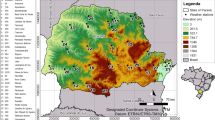Abstract
The possibility is examined that potential evapotranspiration values may be sensitive to changes in atmospheric carbon dioxide content. Enhanced levels of atmospheric CO2 increase water use efficiency of vegetation by improving growth rates and suppressing transpiration per unit leaf area. Highly cultivated crops without water or nutrient constraints are able to show the greatest growth improvements. In many natural or semi-natural ecosystems, under enhanced atmospheric CO2 concentrations, limits on the availability of soil nutrients severely constrains the possibility of improvements in growth and significant increases in leaf area index that could compensate for a decrease in transpiration per unit leaf area. Thus, in many natural or semi-natural ecosystems, which often form water gathering grounds in river basins, enhanced levels of CO2 will suppress transpiration and perhaps increase the proporation of precipitation that forms runoff or ground water. In low vegetation covers, such as grassland, the rates of transpiration and also evaporation from canopies that are wet after rainfall (interception loss) are very similar. In these canopies, evapotranspiration is unlikely to be significantly increased by small increases in leaf area index. It is suggested that the suppression of potential evapotranspiration by enhanced CO2 levels will be small, but that actual transpiration from tall, slow growing vegetation covers may be significantly suppressed. Thus for some vegetation covers the relationship between actual and potential evapotranspiration may be sensitive to CO2 levels. If this is so, it could be of importance to many water balance calculations. The suppression of evapotranspiration by enhanced CO2 levels will be most noticeable in dry climates where interception loss is insignificant and largely masked in very wet climates where a large proportion of evapotranspiration consists of interception loss.
Similar content being viewed by others
References
Arnone, J. A. III and Körner, C.: 1995, ‘Soil and Biomass Carbon Pools in Model Communities of Tropical Plants under elevated CO2’, Oecologia 104, 61-71.
Bazzaz, F. A. and Fajer, E. D.: 1992, ‘Plant Life in a CO2-rich World’, Scient. Amer. 266, 68-74.
Bazzaz, F. A. and Miao, S. L.: 1993, ‘Successional Status, See Size, and Responses of Tree Seedlings to CO2, Light and Nutrients’, Ecology 74, 104-112.
Christophel, D. C.: 1995, ‘The Impact of Climatic Changes in the Development of the Australian Flora’, in National Research Council, Effects of Past Global Change on Life, National Academy Press, Washington, pp. 174-183.
Coughenour, M. B. and Parton, W. J.: 1996, ‘Integrated Models of Ecosystem Function: A Grassland Case Study’, in Walker, B. and Steffen W. (eds.), Global Change and Terrestrial Ecosystems, Cambridge University Press, Cambridge, pp. 93-114.
Cooper, T. A. and Lockwood, J. G.: 1987, ‘The Influence of Rainfall Distribution in Numerical Simulation of Evapotranspiration from a Multilayer Model Pine Canopy’, Water Resour. Res. 23, 1645-1656.
Diaz, S., Grime, J. P., Harris, J., and McPherson, E.: 1993, ‘Evidence of a Feedback Mechanism Limiting Plant Response to Elevated Carbon Dioxide’, Nature 364, 616-617.
Dickinson, R. E.: 1992, ‘Land Surface’, in Trenberth, K. W. (ed.), Climate System Modeling, Cambridge University Press, Cambridge, pp. 149-171.
Doorenbos, J. and Pruitt, W. O.: 1977, ‘Crop Water Requirements’, FAO Irrigation and Drainage Paper, No. 24, FAO, Rome.
Eamus, D.: 1991, ‘The Interaction of Rising CO2 and Temperature with Water Use Efficiency’, Plant Cell Environ. 14, 843-852.
Eamus, D. and Jarvis, P. G.: 1989, ‘The Direct Effects of Increases in the Global Atmospheric CO2 Concentration on Natural and Commercial Temperature Trees and Forests’, Adv. Ecol. Res., 19, 1-55.
Friend, A. D. and Cox, P. M.: 1995, ‘Modeling the Effects of Atmospheric CO2 on Vegetation-atmosphere Interactions’, Agric. For. Meteorol. 73, 285-295.
Gifford, R.M.: 1992, ‘Interaction of Carbon Dioxide with Growth-limiting Environmental Factors in Vegetation Productivity: Implications for the Global Carbon Cycle’, Adv. Bioclimatol. 1, 24-58.
Gifford, R. M., Barrett, D. J., Lutze, J. L., and Samarakoon, A. B.: 1996, ‘Agriculture and Global Change: Scaling Direct Dioxide Impacts and Feedbacks Through Time’, in Walker, B. and Steffen, W. (eds.), Global Changes and Terrestrial Ecosystems, Cambridge University Press, Cambridge, pp. 229-259.
Gleick, P.: 1987, ‘Regional Hydrologic Consequences of Increases in Atmospheric CO2 and Other Trace Gases’, Clim. Change 10, 137-161.
Henderson-Sellers, A., McGuffie, K., and Gross, C.: 1995, ‘Sensitivity of Global Climate Model Simulations to Increased Stomatal Resistance and CO2 Increases’, J. Climate 8, 1738-1756.
Hudson, J. A. and Gilman, K.: 1993, ‘Long-Term Variability in the Water Balances of the Plynlimon Catchments’, J. Hydrol. 143, 355-380.
Idso, S. B.: 1989, Carbon Dioxide and Global Change: Earth in Transition, IBR Press, Tempe.
Jarvis, P. G., James, G. B., and Landsberg, J. J.: 1976, ‘Coniferous Forest’, in Monteith, J. L. (ed.), Vegetation and the Atmosphere 2, Academic Press, London, pp. 171-240.
Jarvis, P. G. and McNaughton, K. G.: 1986, ‘Stomatal Control of Transpiration: Scaling up from Leaf to Region’, Adv. Ecol. Res. 15, 1-49.
Karl, T. R., Jones, P. D., Knight, R. W., Kukla, G., Plummer, N., Razuvayev, V., Gallo, K. P., Lindseay, J., Charlson, R. J., and Peterson, T. C.: 1993, ‘Asymmetric Trends of Daily Maximum and Minimum Temperature’, Bull. Amer. Meteor. Soc. 74, 1007-1023.
Körner, Ch.: 1996, ‘The Response of Complex Multispecies Systems to Elevated CO2’, in Walker, B. and Steffen, W. (eds.), Global Changes and Terrestrial Ecosystems, Cambridge University Press, Cambridge, pp. 20-42.
Körner, Ch. and Arnone, J. A. III.: 1992, ‘Responses to Carbon Dioxide in Artificial Tropical Ecosystems’, Science 257, 1672-1675.
Leichenko, R. M.: 1993, ‘Climate Change and Water Resources Availability: An Impact Assessment for Bombay and Madras, India’, Water Int. 18, 147-156.
Lockwood, J. G.: 1992, ‘The Sensitivity of the Water Balance of a Wet Multilayer Model Pine Canopy to Variations in Meteorological Input’, Clim. Change 20, 23-56.
Lockwood, J. G.: 1993, ‘Impact of Global Warming on Evapotranspiration’, Weather 48, 291-299.
Lockwood, J. G.: 1994, ‘Climatic Change, Grass Pasture and Potential Evapotranspiration’, Weather 49, 318-321.
McKenney, M. S. and Rosenberg, N. J.: 1993, ‘Sensitivity of Some Potential Evapotranspiration Estimation Methods to Climate Change’, Agric. For. Meteorol. 64, 81-110.
McNaughton, K. G. and Jarvis, P. G.: 1983, ‘Predicting Effects of Vegetation Changes on Transpiration and Evaporation’, in Kozlowski, T. T. (ed.), Water Deficits and Plant Growth, Vol. 7, Academic Press, Orlando, pp. 1-47.
McNaughton, K. G. and Jarvis, P. G.: 1991, ‘Effects of Spatial Scale on Stomatal Control of Transpiration’, Agric. For. Meteorol. 54, 279-301.
Marsh, W. M. and Dozier, J.: 1981, Landscape: An Introduction to Physical Geography, Addison-Wesley, MA, pp. 590-593.
Martin, P.: 1989, ‘The Significance of Radiative Coupling between Vegetation and the Atmosphere’, Agric. For. Meteorol. 49, 45-53.
Martin, P., Rosenberg, N. J., and McKenney, M. S.: 1989, ‘Sensitivity of Evapotranspiration in a Wheat Field, a Forest, and a Grassland to Changes in Climate and Direct Effects of Carbon Dioxide’, Clim. Change 14, 117-151.
Mendelsohn, R. and Rosenberg, N. J.: 1994, ‘Framework for Integrated Assessments of Global Warming Impacts’, Clim. Change 28, 15-44.
Monteith, J. L.: 1981, ‘Evaporation and Surface Temperature’, Quart. J. Roy. Meteorol. Soc. 107, 1-27.
Monteith, J. L.: 1986, ‘How do Crops Manipulate Water Supply and Demand?’, Phil. Trans. R. Soc. Lond. (Ser. A.) 326, 245-259.
Monteith, J. L.: 1995, ‘Accommodation between Transpiring Vegetation and the Convective Boundary Layer’, J. Hydrol. 166, 251-263.
Monteith, J. L., Szeicz, G., and Waggoner, P. E.: 1965, ‘The Measurement and Control of Stomatal Resistance in the Field’, J. Appl. Ecol. 2, 345-355.
Monteith, J. L. and Unsworth, M. H.: 1990, Principles of Environmental Physics, Edward Arnold, London, p. 291.
Nemani, R. R. and Running, S. W.: 1995, ‘Satellite Monitoring of Global Land Cover Changes and their Impact on Climate’, Clim. Change 31, 395-413.
Nijs, I., Impens, I., and Behaeghe, T.: 1989, ‘Leaf and Canopy Responses of Lolium Perenne to Long-Term Elevated Atmospheric Carbon-dioxide Concentration’, Planta 177, 312-320.
Oechel, W. C. and Riechers, G. H.: 1986, ‘Impacts of Increasing CO2 on Natural Vegetation, Particularly the Tundra’, in Rosenzweig, C. and Dickinson, D. (eds.), Climate-Vegetation Interactions, Goddard Space Flight Center, Greenbelt, MA, pp. 36-42.
Overdieck, D.: 1993, ‘Erhöhte CO2-Konzentration und Wachstum junger Buchen (Fagus sylvatica)’, Verhandlungen d. Gesellschaft f. Oekologie, Göttingen) 22, 431-438.
Palmer, W. C.: 1965, Meteorological Drought, Research Paper 45, U.S. Weather Bureau, Washington, D.C.
Parton, W. J., Ojima, D. S., and Schimel, D. S.: 1994, ‘Environmental Change in Grasslands: Assessment Using Models’, Clim. Change 28, 111-141.
Penman, H. L.: 1948, ‘Natural Evaporation from Open Water, Bare Soil and Grass’, Proc. R. Soc. London Ser. A 193, 120-146.
Pollard, D. and Thompson, S. L.: 1995, ‘Use of a Land-surface-transfer Scheme (LSX) in a Global Climate Model: The Response to Doubling Stomatal Resistance’, Global Plan. Change 10, 129-161.
Prigogine, I. and Stengers, I.: 1985, Order Out of Chaos, Flamingo, London, p. 349.
Rabbinge, R., van Latesteijn, H. C., and Goudriaan, J.: 1993, ‘Assessing the Greenhouse Effect in Agriculture’, in Lake, J. V., Bock, G. R., and Ackrill, K. (eds.), Environmental Change and Human Health, Ciba Foundation Symposium 175, John Wiley, Chichester, pp. 62-79.
Rind, D., Goldberg, R., Hansen, J., Rosenzweig, C., and Ruedy, R.: 1990, ‘Potential Evapotranspiration and the Likelihood of Future Drought’, J. Geophys. Res. 95, 9983-10,004.
Schäppi, B. and Körner, Ch.: 1995, ‘Growth Responses of an Alpine Grassland to Elevated CO2’, Oecologia 105, 43-52.
Schulze, E.-D., Kelliher, F. M., Körner, Ch., Lloyd, J., Hollinger, D. Y., and Vygodskaya, N. N.: 1996, ‘The Role of Vegetation in Controlling Carbon Dioxide and Water Exchange between Land Surface and the Atmosphere’, in Walker, B. and Steffen, W. (eds.), Global Changes and Terrestrial Ecosystems, Cambridge University Press, Cambridge, pp. 77-92.
Shuttleworth, W. J.: 1983, ‘Evaporation Models in the Gobal Water Budget’, in Street-Perrott, A., Beran, M., and Ratcliffe, R. (eds.), Variations in the Global Water Budget, Reidel, Dordrecht, pp. 147-171.
Tan, C. S. and Black, T. A.: 1976, ‘Factors Affecting the Canopy Resistance of a Douglas-Fir Forest’, Boundary-Layer Meteorol. 10, 475-489.
Thornthwaite, C. W.: 1948, ‘An Approach toward a Rational Classification of Climate’, Geog. Rev. 38, 55-94.
Thornthwaite, C.W. and Mather, J. R.: 1957, ‘Instructions and Tables for Computing Potential Evapotranspiration and Water Balance’, Publications in Climatology 10, Laboratory of Climatology, Centerton, N.J., p. 127.
Van de Geijn, S. C. and Goudriaan, J.: 1996, ‘The Effects of Elevated CO2 and Temperature Change on Transpiration and Crop Water Use’, in Bazzaz, F. A. and Sombroek, W. (eds.), Global Climate Change and Agricultural Production, John Wiley, Chichester, pp. 101-121.
Wallace, J. S., Gash, J. H. C., and Sivakumar, M. V. K.: 1990, ‘Preliminary Measurements of Net Radiation and Evaporation over Bare Soil and Fallow Bushland in the Sahel’, Int. J. Clim. 10, 203-210.
Woodward, F. I.: 1987a, ‘Stomatal Numbers are Sensitive to Increases in CO2 from Pre-Industrial Levels’, Nature 327, 617-618.
Woodward, F. I.: 1987b, Climate and Plant Distribution, Cambridge University Press, Cambridge, p. 174.
Woodward, F. I. (Consortium Leader): 1994, Climate and Vegetation Change: The Influence of Changes in Climate and Carbon Dioxide on Biome Distribution, Interim Report, Project 3b, Tiger IV, NERC.
Author information
Authors and Affiliations
Rights and permissions
About this article
Cite this article
Lockwood, J.G. Is Potential Evapotranspiration and Its Relationship with Actual Evapotranspiration Sensitive to Elevated Atmospheric CO2 Levels?. Climatic Change 41, 193–212 (1999). https://doi.org/10.1023/A:1005469416067
Issue Date:
DOI: https://doi.org/10.1023/A:1005469416067




